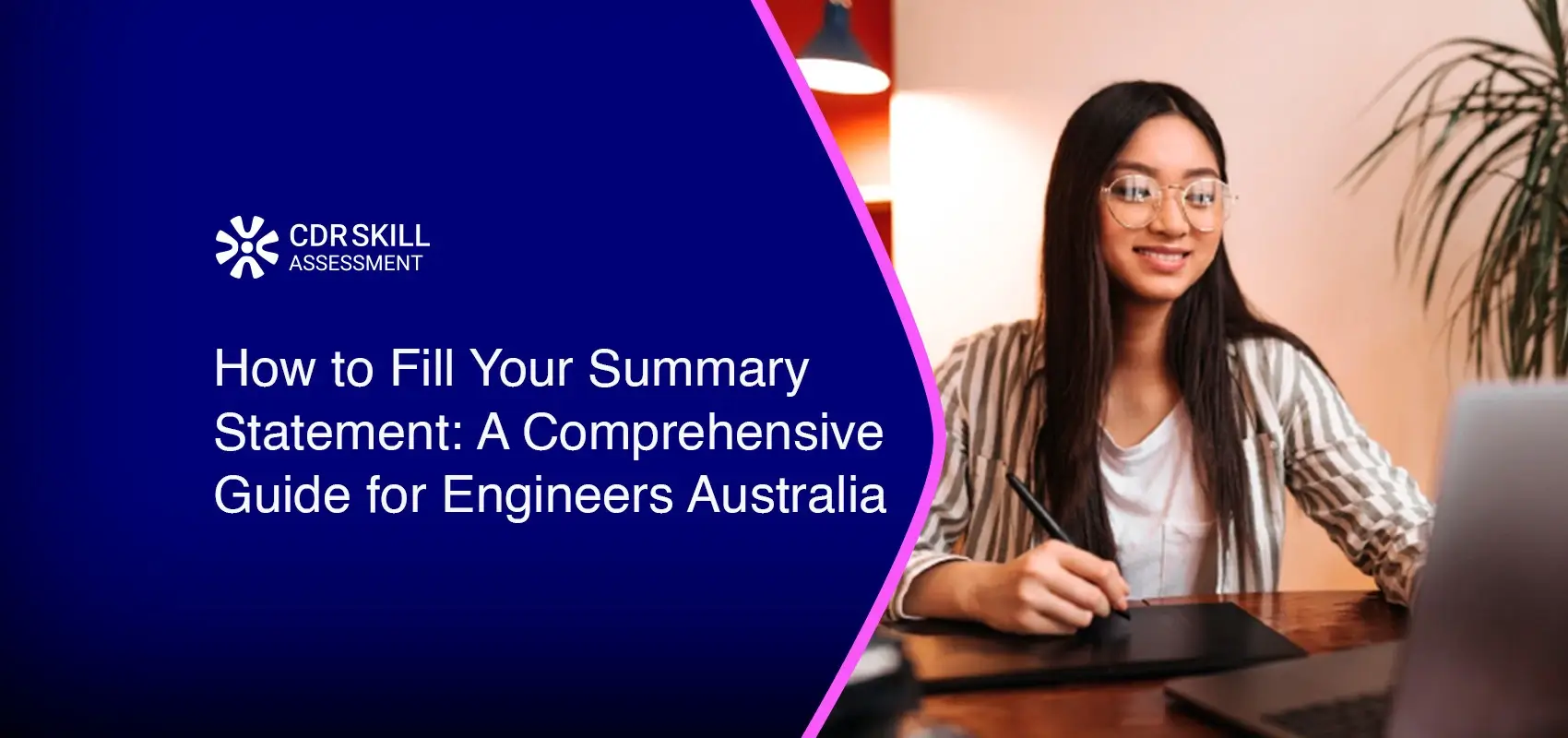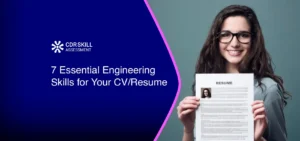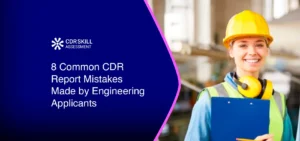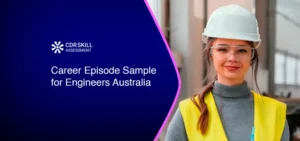Preparing a Competency Demonstration Report (CDR) represents a fundamental milestone for engineers seeking migration to Australia. Among its critical components, the summary statement assumes an indispensable role by systematically linking demonstrated competencies within career episodes to the precise standards articulated by Engineers Australia (EA).
An effective summary statement demands meticulousness, alignment with EA’s expectations, clear articulation, and methodological precision. This guide thoroughly examines the process for developing an exemplary summary statement.
It addresses related considerations such as EA skill assessment fees, career episodes, and the imperative of ensuring originality through plagiarism checks. Whether you are engaging with this process for the first time or familiar with the process, the insights presented here aim to streamline your efforts.
What is a Summary Statement?
The summary statement is a critical part of the CDR report that showcases your engineering competencies by linking them to your career episodes. It serves as a roadmap for EA assessors to quickly verify that you meet the required competency standards.
Each career episode serves as a narrative of specific engineering projects or tasks, and the summary statement bridges these accounts with relevant competency elements defined by Engineers Australia.
For instance, if a career episode illustrates your application of engineering problem-solving techniques, the summary statement explicitly maps this narrative to competency unit “1.2: Application of systematic engineering synthesis and design processes.“
The result is a cohesive document that synthesises your professional experiences and their alignment with EA’s competency standards.
EA Skill Assessment Fees: An Overview
Understanding the financial requirements of the Engineers Australia skill assessment process is a foundational aspect of your preparation. The EA skill assessment fee structure typically encompasses the following components:
- Initial Assessment Fee: Charges for evaluating your CDR report.
- Fast-Track Processing Fee: Optional fees for expedited review.
- Reassessment Fee: Costs incurred for additional reviews following an unsuccessful initial submission.
A comprehensive understanding of these fees, which are periodically updated, ensures informed planning and resource allocation for the assessment process.
Systematic Approach to Filling Your Summary Statement

A. Mapping Competencies to Career Episodes
The cornerstone of an effective summary statement lies in its meticulous mapping of competencies demonstrated in career episodes. Key steps include:
1. Identifying the specific competencies exhibited in each career episode.
2. Referencing the relevant competency standards outlined by Engineers Australia.
3. Assigning appropriate competency codes to activities described. For example:
- Career Episode 1
Demonstrates “1.3: Application of systematic design processes.“
- Career Episode 2
Highlights “2.1: Ethical conduct and professional accountability.“
B. Leveraging the Migration Skills Assessment Booklet
Engineers Australia’s Migration Skills Assessment (MSA) booklet serves as an authoritative reference. It provides:
1. Detailed descriptions of required competencies for specific engineering disciplines.
2. Explicit guidance for structuring career episodes and summary statements.
Careful adherence to the MSA booklet ensures that your submission aligns precisely with EA’s evaluative criteria.
C. Achieving Precision in Documentation
A cogent summary statement demands precision and clarity. Best practices include:
1. Conciseness with Specificity
Replace general statements such as “Managed a team effectively” with evidence-backed descriptions like “Led a multidisciplinary team of five engineers to design and implement a wastewater treatment plant, integrating leadership with technical innovation.”
2. Structural Clarity
Utilise bullet points to delineate competencies.
3. Consistent Referencing
Ensure that references to career episodes and competency units are systematically maintained throughout the summary statement.
Strengthening Career Episodes for Enhanced Coherence
The efficacy of your summary statement is contingent upon well-articulated career episodes. Recommendations include:
- Distinct Focus
Centre each career episode around a singular engineering project or challenge.
- Triadic Framework
Delineate the problem encountered, the actions undertaken, and the outcomes achieved.
- Competency Alignment
Link specific aspects of your narrative to predefined competency units.
For instance, a career episode addressing a renewable energy project should underscore how your contributions advanced sustainability objectives while mapping explicitly to competency elements such as “2.3: Application of systematic approaches to the conduct and management of engineering projects.“
Common Pitfalls in Summary Statement Preparation

Awareness of recurrent errors in summary statement preparation can significantly enhance the quality of your submission. Notable pitfalls include:
a. Inadequate Alignment with Career Episodes
Failing to link each competency in the Summary Statement to specific evidence from your career episodes. A common mistake is mentioning a competency without clearly demonstrating how it was achieved or supported by your work experience.
Solution: Ensure that every competency cited in the summary statement is substantiated by specific evidence from career episodes. Draw direct references from your episodes, ensuring clear connections between your tasks, actions, and outcomes that align with the Engineers Australia competency standards.
b. Excessive Generalisation
Using vague or broad statements like “I solved complex problems” or “I worked in a team,” which don’t provide sufficient detail to demonstrate your abilities. These generalisations lack the depth needed to highlight your expertise.
Solution: Replace vague claims such as “I solved complex problems” with detailed accounts of the problem-solving process, including challenges faced, the steps you took to resolve them, and the measurable outcomes. Be specific about the technical skills applied, the tools or methods used, and the results you achieved.
c. Neglect of Plagiarism Verification
Copying content from other applicants or online sources can result in the rejection of your application. Engineers Australia checks for originality, and submitting plagiarised material will improve your chances.
Solution: Originality is a non-negotiable criterion. Employ robust plagiarism-checking tools to guarantee the authenticity of your content. Always ensure your summary statement is unique and reflects your personal experiences. To guarantee the authenticity of your content, use reliable plagiarism-checking tools before submission.
d. Lack of Clarity and Relevance
Failing to link the career episodes to the competency elements in the summary statement. Each competency element needs to be demonstrated with direct references to the career episodes.
Solution: Ensure that each section of your summary statement addresses the specific competency elements outlined by Engineers Australia. Draw direct references from your career episodes to showcase how your experience aligns with these competencies.
e. Overlooking the Engineers Australia Competency Standards
Not aligning the summary statement with the specific competency standards outlined by Engineers Australia.
Solution: Familiarise yourself with Engineers Australia’s competency standards and ensure each section of your summary statement directly addresses these criteria. Be sure to refer to relevant aspects of the engineering knowledge, skills, and abilities that are required.
f. Incorrect or Inconsistent Formatting
Using incorrect formatting or inconsistent structure makes the summary statement hard to follow.
Solution: Follow the Engineers Australia guidelines for formatting the summary statement. Use a clear and logical structure with headings and subheadings that make it easy for the assessors to follow your responses.
Topics to Explore in Summary Statement Preparation

1. Importance of Adhering to Professional Writing Standards
Professionalism in writing ensures that your summary statement reflects clarity, precision, and a structured approach, critical for assessors’ understanding.
2. Addressing Gaps Between Career Episodes and Competencies
Identifying and addressing gaps where competencies are underrepresented in career episodes is essential for creating a robust narrative.
3. Customising Content for Different Engineering Disciplines
Tailoring your summary statement to reflect the specific competency requirements of your engineering discipline enhances its relevance and effectiveness.
4. Techniques for Showcasing Leadership and Innovation
Highlighting instances of leadership and innovative problem-solving underscores your ability to contribute meaningfully to engineering projects.
5. Strategies for Maintaining Objectivity
Adopting an objective tone and avoiding exaggerated claims ensures credibility and alignment with Engineers Australia’s standards.
Ensuring Originality: The Role of Plagiarism Checks in CDR Report Preparation
Engineers Australia enforces stringent anti-plagiarism policies, and non-compliance can result in rejection or disciplinary action. To safeguard your submission:
- Use reputable plagiarism-checking tools such as Turnitin or Grammarly.
- Paraphrase effectively while preserving technical accuracy.
- Attribute referenced materials correctly, adhering to established citation norms.
If required, consider enlisting professional services for comprehensive plagiarism analysis and mitigation.
Learn more: CDR samples for different engineering disciplines. ✨💯💥
The Value of Professional Assistance in CDR Report Preparation
The complexity of the CDR preparation process often warrants professional guidance. Reputable services such as CDRskillassessment.com provide:
- Expertise in drafting career episodes and summary statements.
- Meticulous plagiarism verification and reporting.
- Comprehensive reviews for compliance with EA standards.
Such assistance can substantially elevate the quality and coherence of your summary statement for submission.
Conclusion
A meticulously crafted summary statement is the backbone of a successful Engineers Australia CDR report submission. By systematically aligning demonstrated competencies with EA’s standards and adhering to best practices outlined in this guide, applicants can maximise their chances of achieving a favourable outcome.
Dedication to detail, originality, and professional standards are paramount. When in doubt, leverage expert guidance to navigate the complexities of the CDR preparation and review process and advance your engineering career aspirations in Australia.
A well-prepared summary statement reflects your understanding of Engineers Australia’s requirements and your ability to present technical expertise coherently. Navigating the intricacies of the CDR process can be challenging, but with careful planning, thorough research, and meticulous documentation, success is achievable.
For individuals uncertain about their submissions, seeking expert guidance ensures alignment with EA standards while offering valuable insights into areas for improvement. As you finalise your summary statement, remember that this document serves as a bridge to your professional aspirations in Australia—treat it with the diligence it warrants.
By investing effort and attention, you position yourself to advance confidently in your engineering career.
FAQs
1. What function does the summary statement serve in a CDR?
The summary statement synthesises competencies from career episodes, directly mapping them to Engineers Australia’s competency standards. It enables assessors to evaluate your professional qualifications efficiently.
2. What are the associated costs of the Engineers Australia skill assessment?
Costs vary based on the specific services requested, including initial assessments, fast-tracked evaluations, and reassessments. Consult the latest fee schedule on Engineers Australia’s official website.
3. How can plagiarism-free content be ensured in CDR report preparation?
Employ advanced plagiarism-detection tools, adhere to meticulous paraphrasing practices, and consult professional services when necessary to ensure originality.
4. What is the importance of aligning career episodes with competency elements?
Aligning career episodes with competency elements ensures that your submission adheres to Engineers Australia’s guidelines and facilitates an efficient assessment of your qualifications.
5. How often does Engineers Australia update its fee structure?
Engineers Australia periodically revises its fee structure. Applicants should regularly consult the official website for the most accurate and up-to-date information.
6. Can I reuse previous project reports in my CDR?
Yes, but they must be tailored to meet Engineers Australia’s competency standards. Additionally, ensure originality to avoid potential plagiarism issues.
7. What role does the MSA booklet play in the CDR process?
The MSA booklet provides detailed guidance on preparing career episodes and summary statements, ensuring alignment with Engineers Australia’s evaluation criteria.
8. Are professional CDR report writing services reliable?
Reputable services can enhance the quality of your CDR report by providing expertise in drafting and compliance checks. However, exercise due diligence when selecting a service provider.




